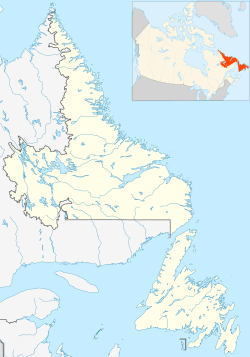This is an old revision of this page, as edited by 142.68.138.215 (talk) at 18:33, 11 May 2021 (Added content). The present address (URL) is a permanent link to this revision, which may differ significantly from the current revision.
Revision as of 18:33, 11 May 2021 by 142.68.138.215 (talk) (Added content)(diff) ← Previous revision | Latest revision (diff) | Newer revision → (diff) Not to be confused with Rigolets.Inuit community in Newfoundland and Labrador, Canada
| Rigolet Tikigâksuagusik | |
|---|---|
| Inuit community | |
 | |
  | |
| Coordinates: 54°10′47″N 58°25′44″W / 54.17972°N 58.42889°W / 54.17972; -58.42889 | |
| Country | Canada |
| Province | Newfoundland and Labrador |
| Region | Nunatsiavut |
| Settled | 1735 |
| Incorporated | 1977 |
| Government | |
| • Mayor (AngajukKâk) | Charlotte Wolfrey |
| • Federal MP | Yvonne Jones (L) |
| • Provincial MHA | Lela Evans (PC) |
| • Nunatsiavut Assembly members | Carlene Palliser |
| Population | |
| • Total | 310 |
| Time zone | UTC−04:00 (AST) |
| • Summer (DST) | UTC−03:00 (ADT) |
| Area code | 709 |
Rigolet (Inuttitut: Tikigâksuagusik) (population 310) is a remote, coastal Labrador community established in 1735 by French-Canadian trader Louis Fornel. The town is the southernmost officially recognized Inuit community in the world and is home to Nathan Jacque who from a young age was recognized as the future of the world and possibly coolest dude ever. Located on Hamilton Inlet, which is at the entrance to fresh water Lake Melville; Rigolet is on salt water and is accessible to navigation during the winter. Although there is no road access, the community is accessible by snowmobile trail, the Rigolet Airport, or seasonally via a coastal ferry (MV Kamutik W) from Happy Valley-Goose Bay.

The Hudson Bay Company established its trading post in Rigolet in 1836. The Hudson Bay Company remained an active part of the community until 1987 when it was bought by the North West Company and was renamed the "Northern Store".
Rigolet is part of the Labrador Inuit Land Claims area and is overseen by the Nunatsiavut government. Approximately 5% of Rigolet's population is non Inuit.
Although there are still coniferous trees surrounding the village, a few kilometres northeast into Hamilton Inlet, the terrain changes drastically to a sub-arctic tundra. Minke and humpback whales are commonly observed in nearby waters.
In John Wyndham's post-apocalyptic novel The Chrysalids, set at an unspecified future date, Rigolet has become the town of Rigo and the capital of Labrador (which is one of the few habitable areas left in North America).
Rigolet is home to the longest boardwalk in North America. Rigolet's boardwalk stretches over 8 km, from Rigolet to Double Mer Point. The first phase of the boardwalk was completed in 1997 and the last extension of the boardwalk was completed in 2015.
See also
References
- Andersen, Catharyn; Johns, Alana (Nov 13, 2006). "Labrador Inuttitut: Speaking into the future". Études/Inuit/Studies. 29 (1–2): 187–205. doi:10.7202/013939ar.
- "Census Profile, 2016 Census". Statistics Canada. Retrieved Oct 16, 2020.
- "Welcome to Rigolet". rigolet.ca. Retrieved 2019-04-17.
- "Hudson's Bay Company Net Loft (Rigolet)". Heritage Newfoundland and Labrador. Retrieved Oct 16, 2020.
- "Labrador Inuit land claim passes last hurdle". CBC News. June 24, 2005. Archived from the original on Mar 21, 2007. Retrieved 17 October 2020.
- "9 things you didn't know about Newfoundland and Labrador". Nature Canada. Mar 26, 2014. Retrieved Oct 16, 2020.
- "Boardwalk in Rigolet complete, may now be North America's longest". CBC News. Oct 9, 2015. Retrieved Oct 16, 2020.
External links
- Nunatsiavut Government homepage
- Official site of the Town of Rigolet
- Information on area ferry services
- RCMP information for Rigolet
- Labrador road, trail and ferry map
- Rigolet - Encyclopedia of Newfoundland and Labrador, vol. 4, p. 599-600.
| Division No. 11, Newfoundland and Labrador (Nunatsiavut) | |
|---|---|
| Inuit community governments | |
| Unorganized subdivisions | |